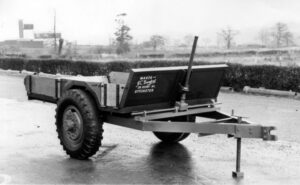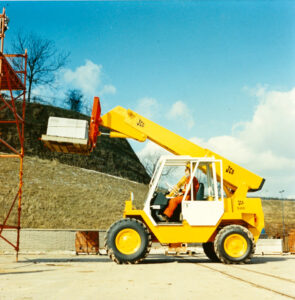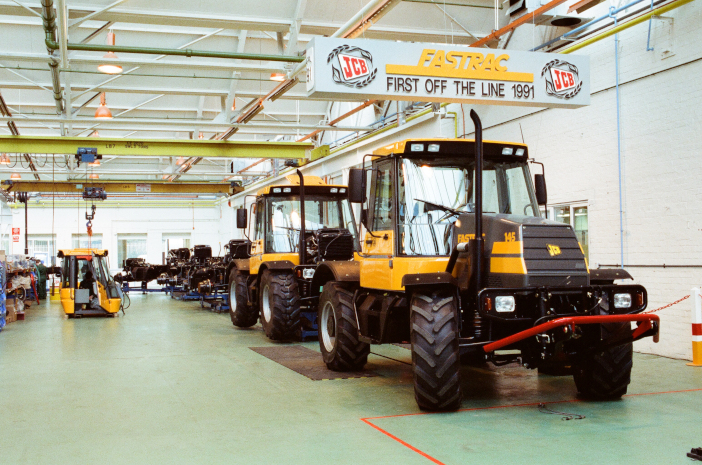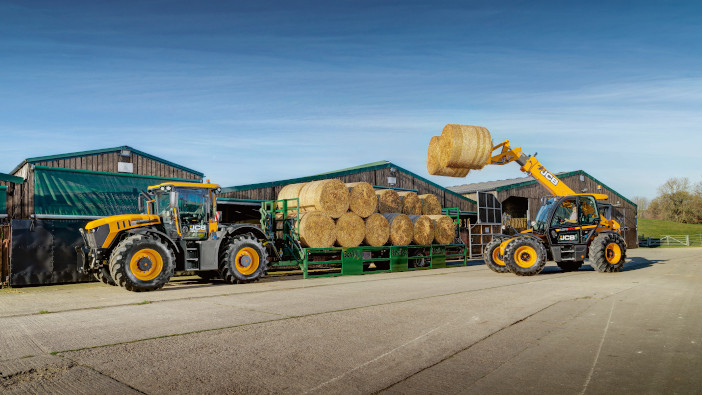JCB has been celebrating its 80th Anniversary year throughout 2025, highlighting the company’s track record of agricultural machinery development that started with farm trailers and led to today’s high-performance telehandlers and sophisticated farm tractors.
The JCB story begins in 1945 in a small garage building in Staffordshire when Joe Bamford left the family business to set up on his own – coincidentally, on the day his first son, Anthony, now Lord Bamford, JCB Chairman, was born.
The company’s first product was a simple wooden-bodied screw-jack tipping trailer, now displayed at the entrance to JCB World Headquarters at Rocester, Staffordshire.
With materials in that post-WW2 period in short supply, a fair degree of ingenuity was needed to find components, so the first trailer sports an axle, rims and tyres from an old Albion truck.
A subsequent four-wheeler featured wheels from a Grumman Hellcat fighter aircraft bolted to hubs from a small howitzer artillery piece, each hub being welded to a 4inx3in rolled steel joist forming the axle, while steel bodywork was constructed from sheets of bomb shelter corrugated iron rolled flat, then cut and welded to size.

A hydraulic tipping mechanism followed once tractors could provide a source of oil and this led in turn to Joe Bamford’s first loader, the Major, introduced in 1948, the smaller Master and, in 1953, the Si-draulic, an offset tractor loader with a single tubular beam positioned down the left side of the host tractor, with one large hydraulic cylinder to lift and lower it.
His first backhoe – the tractor-mounted MK1 with 180 degree slew that enabled farmers to clean out their ditches – made its debut in the same year and, when paired with a Major front loader, set the pattern for the JCB backhoe-loader.
Early in 2025, total production exceeded one million units, underscoring the continued appeal of a machine seen in all parts of the world and which remains the market leader by some margin.
Construction and agriculture
Tracked excavators for earth moving and land drainage works followed in 1964 as the backhoe-loader took JCB increasingly into the construction equipment market, and then loading shovels, first with the 1968 acquisition of Chaseside, and then in 1971 with JCB’s own 413 and 418.
These had an articulated chassis design with the cab mounted on the front half of the chassis to give the driver a clear view of the loader arms, and with the engine and transmission on the rear half for balance.
That layout would switch to a more conventional arrangement with the launch of the 410 in 1981 and the first agricultural-spec model – the JCB 410 Farm Master – in 1983.
Today’s range of JCB wheeled loaders, all purpose-built for agriculture, comprises models of all sizes, from the ultra-compact 403 with diesel and electric power to the giant 435S and 457S that comfortably lead the market for big-output agricultural loaders.

A greater impact on farming and construction could be seen in 1977 with the launch of the JCB 520 telescopic handler, a machine that could not only lift and load but also use its telescopic boom to reach over and upwards, enabling bedding to be placed into cattle sheds without venturing through a gate, push-up grain into piles and stack bales higher and more efficiently than any tractor-based loader could manage.
The idea caught on – in construction as well as farming; four years after the 420’s introduction, JCB had produced 1,000 telescopic handlers, and in 1984, annual production had reached 1,000 units.
Subsequent models, given the now familiar Loadall name, accelerated production volumes until telescopic handlers became JCB’s second-largest product line after the backhoe.
In 1995, JCB engineers made the decision to capitalise on its 26 years of loading shovel experience and 22 years of telescopic handler expertise to produce the 409 TeleMaster, the company’s first telescopic wheeled loader. Combining the talents and all-round visibility of an articulated wheeled loader chassis with the versatility of a telescopic boom proved popular with dairy and other livestock farmers who liked the familiarity and all-round visibility provided by the high-set central driving position.
Today, the line-up extends to nine models with the recent launch of the 1.1 tonne lift TM110 ultra-compact machine and the 2.85 tonne TM280/TM280S mid-range models.
A JCB tractor…
JCB Chairman Anthony Bamford, who took on the role in 1975 when his father Joe retired, then came up with a fresh challenge – building a farm tractor.
Road transport – conveying harvested crops from ever more distant fields as farms grew – was an increasingly important function for tractors that at the time were limited to 30kph (19mph) or at best 40kph (25mph) on the road.
The original concept for Project 130 was therefore as a transport-first tractor also capable of field work, when the priority for conventional tractors was the other way round.

When unveiled at the Royal Smithfield Show in 1990, the newly christened Fastrac set the mould for all subsequent models, with front axle suspension and self-levelling rear axle suspension combining with truck-like braking performance to allow a top speed of 75kph (47mph).
Attaching the lower arms of the Fastrac’s three-point linkage to the back axle meant full suspension travel and more favourable weight distribution could be maintained with mounted implements, which, despite running on modest 30in rims all round, enabled the Fastrac to successfully plough and carry out other draft field work.
How fitting that the just-launched Fastrac 6000 Series – two models with 284hp (212kW) and 335hp (250kW) –with additional features and digital technology to further lift performance, productivity and the operating experience, should be unveiled in the 80th Anniversary year of JCB, a hugely successful, endlessly innovative British manufacturer of agricultural and construction equipment.


